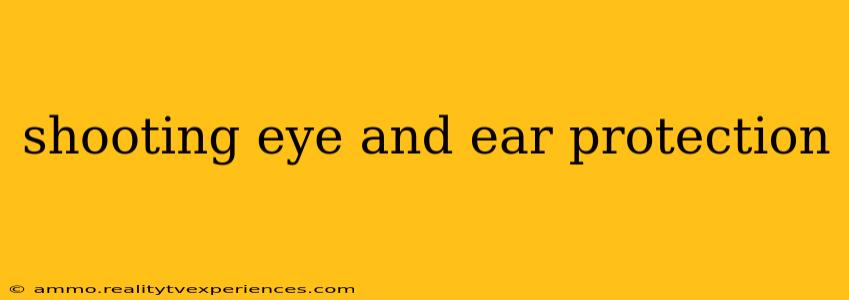Shooting sports, whether hunting, target practice, or competitive shooting, demand unwavering commitment to safety. Among the most critical safety measures are the consistent use of eye and ear protection. Neglecting this crucial aspect can lead to severe and permanent injuries, dramatically impacting your quality of life. This comprehensive guide explores the types, features, and importance of shooting eye and ear protection.
The Importance of Eye and Ear Protection
The high-velocity projectiles and intense noise associated with firearms pose significant risks to both your vision and hearing. Even seemingly minor incidents can result in catastrophic consequences.
-
Eye Injuries: Debris from the target, projectile fragments, and even propellant gases can cause severe eye injuries, leading to blindness or impaired vision. High-velocity impacts can rupture the eyeball or damage the optic nerve.
-
Hearing Damage: The noise generated by firearms far exceeds safe exposure limits. Repeated exposure to loud noises, even without immediate discomfort, contributes to noise-induced hearing loss (NIHL), a progressive condition characterized by tinnitus (ringing in the ears), hyperacusis (increased sensitivity to sound), and reduced hearing ability. NIHL is irreversible and can significantly affect your quality of life.
Ignoring these risks can have a devastating impact, both personally and financially. Investing in quality eye and ear protection is an investment in your long-term health and well-being.
Types of Eye Protection for Shooting
The best eye protection for shooting offers impact resistance, clarity, and comfort. Several types cater to different needs and preferences.
Shooting Glasses:
These are the most common type of eye protection. Look for glasses that meet ANSI Z87.1 standards, indicating they've passed rigorous impact testing. Features to consider include:
- Impact Resistance: The higher the impact resistance rating, the better.
- Lens Material: Polycarbonate is a popular choice due to its lightweight nature and high impact resistance.
- Lens Tint: Different tints cater to various lighting conditions. Clear lenses are suitable for indoor ranges, while darker tints are ideal for bright outdoor settings.
- Wrap-Around Design: This design helps prevent debris from entering the sides of the glasses.
Shooting Goggles:
Goggles provide superior protection compared to glasses, fully enclosing the eyes and offering complete protection from debris. They are particularly important when shooting in dusty or dirty environments.
Choosing the Right Ear Protection
Selecting suitable ear protection is just as crucial as selecting the right eye protection. Noise reduction rating (NRR) is a key indicator of their effectiveness.
Hearing Protection Options:
-
Earmuffs: These offer excellent noise reduction and are comfortable for extended periods. Look for earmuffs with a high NRR and a comfortable fit. Electronic earmuffs amplify ambient sounds while reducing loud noises, which can be particularly beneficial for hunters or those on the shooting range who need to communicate.
-
Ear Plugs: These are smaller and more portable than earmuffs, fitting inside the ear canal. They are effective but may not be as comfortable for extended use. Foam earplugs are a cost-effective option, while reusable silicone earplugs offer better hygiene and longevity. Custom-molded earplugs offer the best fit and noise reduction but require a professional fitting.
Maintaining Your Safety Gear
Regular maintenance is essential to ensure your eye and ear protection continues to perform optimally.
- Clean Regularly: Clean your glasses and goggles with a soft cloth and lens cleaner, avoiding harsh chemicals.
- Inspect for Damage: Check your eye and ear protection before each use for any cracks, scratches, or damage. Replace any damaged gear immediately.
- Store Properly: Store your safety gear in a clean, dry place, away from direct sunlight and extreme temperatures.
Conclusion
Investing in quality shooting eye and ear protection is a non-negotiable aspect of responsible firearm handling. By understanding the available options and prioritizing proper use and maintenance, you can significantly reduce the risk of permanent hearing loss and eye injury, ensuring a safer and more enjoyable shooting experience for years to come. Remember, your safety is paramount.

